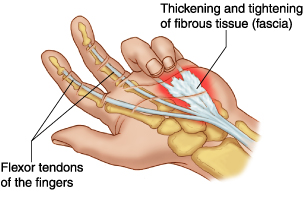Dupuytrens Contracture
Dupuytrens Contracture is a hand deformity that usually develops slowly, over years. Dupuytrens affects a layer of tissue, called fascia, that lies under the skin of the palm. Knots of tissue form under the skin, eventually forming a thick cord that can pull one or more of the fingers into the palm.
Once this occurs, the affected fingers cannot be straightened completely, complicating everyday activities such as placing your hands in your pockets, putting on gloves or shaking hands.
Dupuytrens Contracture most commonly affects the ring and small fingers but can affect any finger including the thumb. It occurs most often in older men of Northern European descent. It is usually a painless condition and affects both hands.
Treatment
Surgery
Surgery, sometimes referred to as a palmar fasciectomy, is often recommended when the contracture has progressed to a point where function is significantly limited. Surgery for Dupuytrens Contracture divides or removes the thickened bands to help restore finger motion. Sometimes the wound is left open and allowed to heal gradually. Although rare, risks of surgery include injury to nerves and blood vessels, and infection. Permanent stiffness of the fingers may occur, although this is also rare.
Enzyme Injection
An enzyme injection has recently been approved by the FDA for treatment of Dupuytrens Contracture. It is being administered by surgeons trained in the technique. The enzyme is able to break down the tough bands and improve motion without surgery.
After numbing the hand with a local anesthetic injection, the surgeon injects the enzyme directly into the diseased tissue. During the hours following the injection, the enzyme dissolves the contracted tissue, allowing the finger to be straightened.
This procedure is performed in the doctor’s office. Complications of the injection may include allergic reactions or flexor tendon tears. Other complications include those listed above for surgery. Early results are promising, but long-term recurrence rates have not yet been reported.
Needle Aponeurotomy
Needle aponeurotomy is another new, less invasive procedure being performed by some surgeons. After numbing the hand with a local anesthetic injection, the surgeon uses a hypodermic needle to divide the diseased tissue. No incision is required and this procedure can be done in the doctor’s office. Complications are no greater than with surgery and the patient experiences less pain and swelling immediately after the procedure. Long-term recurrence rates are unknown with this approach.
Therapy
Therapy has not been shown to slow down, stop or reverse the progression of Dupuytrens however following surgery, or any of the other treatment methods identified above, Hand Therapy can be extremely effective in maximizing range of motion and function.
The use of a custom made splint to maintain extension of the digits at night can be extremely effective. Adding a silicone elastomer mold to the splint can also help reduce the density of the scar.
Range of motion exercise and strengthening can be beneficial however, overly aggressive therapy can result in a dramatic increase in swelling, pain and ultimately stiffness. Choosing a well qualified Hand Therapist is recommended to ensure good results.
If you have any questions about Dupuytrens Contracture or anything else related to Hand Therapy please call or e mail us. We would be happy to help in any way we can.












